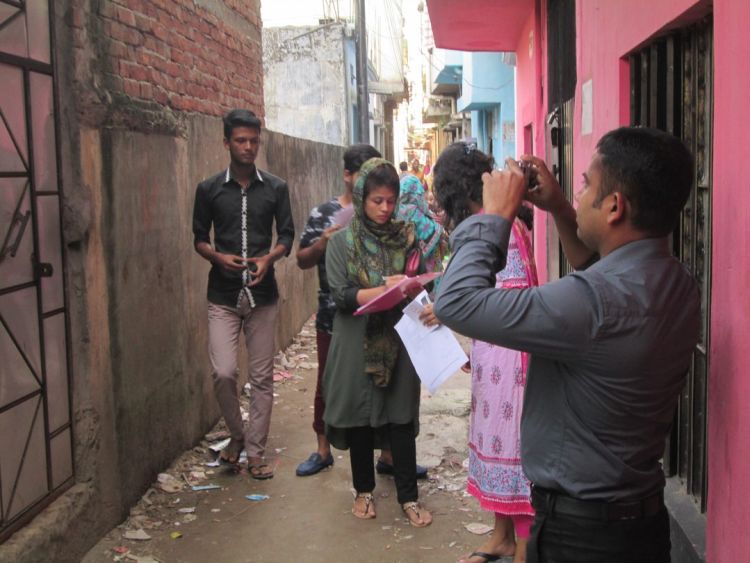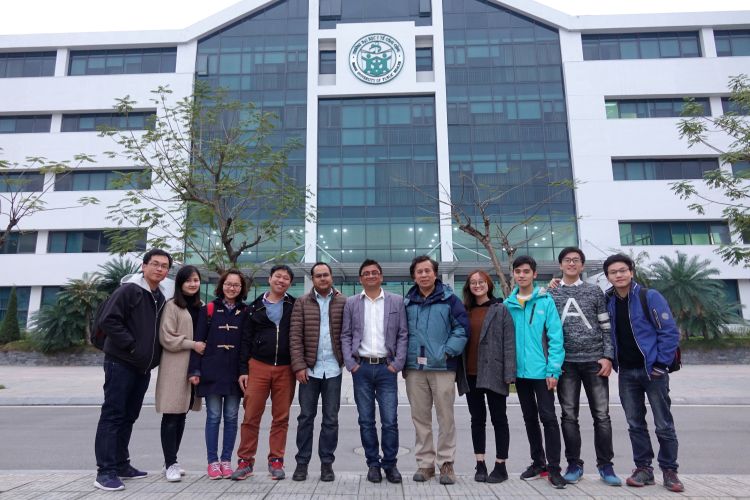Research project
Surveys for Urban Equity
- Start date: 1 April 2017
- End date: 31 March 2019
- Value: £599,737
- Partners and collaborators: The Hanoi University of Public Health, Centre for Injury Prevention and Research (CIPRB), The ARK Foundation, Health Research and Social, Development Forum International (HERDi), Worldpop/Flowminder at University of Southampton Funded by: the Medical Research Council's Global Challenges Research Fund.
Description
Surveys for Urban Equity: getting and using the data to respond to Non-Communicable Diseases in urban areas
For public health services to respond to the growing burden of NCDs among the urban poor, the proper measurement of disease prevalence, risk factors and behaviours is a crucial first step. In LMICs, household surveys – such as Demographic and Health Surveys (DHS) and WHO’s Stepwise Approach to Surveillance (STEPS) – provide vital data sources to inform national health sector planning in over 90 LMIC countries. However, the way these surveys are currently designed and presented undermines their use by decision-makers to monitor inter- and intra-urban-health and plan interventions, and particularly to respond to the health needs of the poorest. The under-representation of the urban poor in these surveys means that health issues they experience are masked by the better health outcomes among the urban wealthy. This provides an overly rosy picture of urban health.
Furthermore, while there is increasing attention paid to the four main NCDs – cardiovascular diseases, cancers, chronic respiratory diseases and diabetes – other NCDs of importance to the urban poor, in particular accidents and injuries and mental health, are frequently overlooked in research and response.
There is an urgent need to find ways of presenting data clearly and accessibly to help decision-makers target resources and services to those who most need them. Currently, important findings from household surveys are hidden in wordy reports. This means they do not inform planning and management decisions such as where to locate health centres or which risk factors and groups to target through health promotion.
Our GCRF Foundation Award aims to address these problems by testing novel survey sampling and mapping approaches, piloting questionnaires on mental health and injuries, exploring the nature and definitions of urban poverty and households and working closely with urban-health decision-makers to find the best ways to present and use the data we collect.
Progress Updates
October 2017
The participatory methods with poor urban communities are now well underway in all three cities.
The teams in each city have used photovoice, social mapping and wealth ranking to understand the characteristics of poverty in urban poor neighbourhoods.
November 2017
Helen and Dana from the SUE study team recently participated in a high-level meeting with UNHABITAT, UNFPA, National Statistical Agencies, researchers, non- governmental organizations (NGOs), and bilateral donors to propose a global definition of slum areas to be used in the identification of slums in censuses, household surveys and policy-making in LMICs.
See the following link for more information: https://unhabitat.org/distinguishing-slum-from-non-slum-areas-to-identify-occupants-issues/
January 2018
The HERD team in Nepal have now successfully completed their survey, recruiting 1123 households and gaining valuable insights into the use of the novel methods.
Radheshyam and Rajeev from the HERD team are now supporting the survey teams in Dhaka (CIPRB) and in Hanoi (HUPH) to use the methods within their surveys which will be happening in the next few months.
September 2018
Please read our Planning Team Guide to understand the purpose of the Surveys for Urban Equity (SUE) project and learn more about the project's new methods and tools.
Objectives
1) Establish and strengthen collaborations with health research institutions, international and national bodies conducting cross-sectional household surveys, national and local government departments and academics to share expertise and build capabilities on survey design, assessment of wealth, mental health and injuries, data visualisation and use of data to address urban inequities.
2) Adapt, in close collaboration with decision-makers in Bangladesh, Nepal and Vietnam, existing surveys to enhance understanding of mental health and injuries among urban populations: by:
a) Assessing the literature and existing questionnaires to measure mental ill-health and injury;
b) Understand perceptions, experiences and terminology of mental health and injury in slums;
c) Agree a questionnaire using questions from existing surveys adapted for urban appropriateness;
d) Assess comprehensibility and acceptability of the agreed questionnaire among urban slum residents and identify the best mode of delivery;
3) Identify appropriate measures of urban wealth for use within household surveys;
4) Assess the extent and nature of data use in planning and management processes and practices within municipalities, including key influences on the degree of data use;
5) Engage closely with municipalities to develop appropriate and feasible data visualisation tools to support planning and management;
6) Pilot our novel sampling, mapping, enumeration and visualisation methods.
Methods
During this foundation stage we will pilot the novel survey methods in Kathmandu before exploring the feasibility of their use in Vietnam and Bangladesh. This will be done in a sample of 1200 in the Kathmandu Valley. We will assess the ability of the new methods to identify urban dwellers who would have been excluded from traditional-style household surveys. We will then pilot the methods in Hanoi and Dhaka on a smaller scale.
We will use qualitative methods with poor urban communities to understand the nature of urban poverty and households in each of the three cities. We will analyse our questionnaire data to compare measures of wealth/poverty to identify which are most appropriate for differentiating between wealth groups across the 3 cities.
We will work closely with urban-health decision-makers, using qualitative interviews and observation to understand their use of data in planning. Our research partners will then facilitate ‘communities of practice’ to work with groups of decision-makers to explore different ways of presenting and using data.
View our video of Hanoi team's experience of using the new methods.
Read the full details of our study protocol.
Partners & Collaborators
In Vietnam:
In Bangladesh:
In Nepal:
At the University of Southampton:
- ‘Worldpop’ population mapping project
Further contacts and information
For more information please contact any member of the project team directly.
The Nuffield Centre for International Health and Development, LIHS, University of Leeds
- Dr Helen Elsey, Principal Investigator
- Prof James Newell, Advisor
- Prof Tim Ensor, Lead- Wealth/Poverty Measurement
- Dr Tolib Mirzoev, Lead- Data for Decision Making
- Dr Rebecca King, Anthropologist
- Dr Joe Hicks, Statistician
- Dr Ak Narayan Poudel, Research Fellow/Project Coordinator
- Mr Chris Cartwright, Public Health Specialist
- Miss Caroline Tait, Public Health Specialist
HERD International (Nepal)
- Dr Sushil Baral, Co-Principal Investigator
- Mrs Sudeepa Khanal, Project Manager
- Mr Radheshyam Bhattarai, Survey Coordinator
- Miss Shraddha Manandhar, Qualitative Researcher
- Mr Rajeev Dhungel, IT Specialist
- Mr Subash Gajurel, Survey Researcher
- Ms Puja Kc, Assistant Data Management officer
CIPRB (Bangladesh)
- Dr Saidur Mashreky, Co-Principal Investigator
- Dr Junnatul Ferdoush, Research Associate
ARK Foundation (Bangladesh)
- Dr Rumana Huque, Co-Principal Investigator
- Dr Shammi Nasreen, Research Fellow
- Ms Tarana Ferdous, Research Associate
Hanoi University of Public Health (Vietnam)
- Dr Hoang Van Minh, Co-Principal Investigator
- Dr Duong Minh Duc, Research Fellow
- Ms Nguyen Bao Ngoc, Qualitative Researcher
- Ms Doan Thi Thuy Duong, Qualitative Researcher
- Mr Duong Kim Tuan, Quantitative Researcher
- Mr Vu Hai Dang, Data Collection Assistant
- Mr Cao Huu Quang, Data Management Assistant
- Mr Nguyen Thanh Long, Data Collection Assistant
- Ms Duong Hai Yen, Data Collection Assistant
University of Southampton (UK)
- Dana Thomson, Consultant- Novel Survey Methods
University of Notre Dame (Australia)
- Dr Hilary Wallace, Injury Consultant
Impact
Data on the health needs of the urban poor, particularly their risks to and burden of NCDs, is vital to addressing the changing disease burden driven by rapid, uncontrolled urbanisation in LMICs. Our focus on supporting municipalities to use this data for equity analysis will provide the evidence needed to direct resources to health programmes – both preventative and curative - that target the urban poor.




